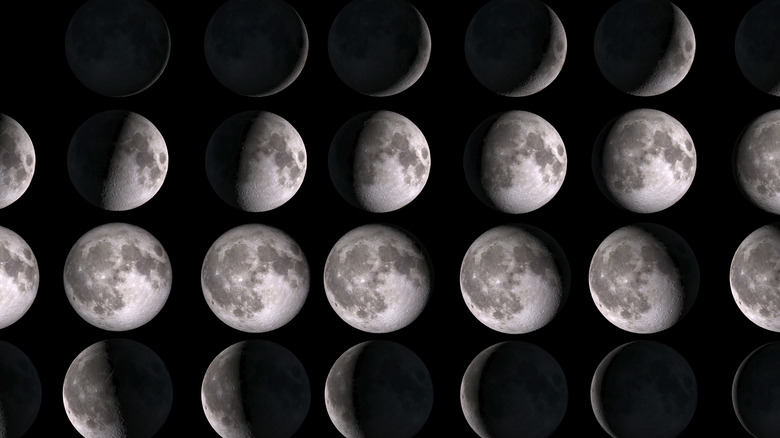What Does It Mean To Garden By The Moon?
When we use the phrase "gardening by the moon," or "lunar planting," we're referring to the practice of planning our garden tasks in accordance with the phases of the moon, as well as its position amongst the astrological zodiac. This way of growing crops aims to keep us in alignment with nature, and humans have implemented it for as long as we've planted gardens. The gist is that lunar planting considers the fact that the moon's gravitational pull affects moisture levels in the soil, just as it impacts ocean tides. Increased moisture is available to seeds planted around the time of either a full or new moon, which leads moon gardeners to speculate that those seeds will fare better than others.
For anyone who enjoys gardening, and especially those who prefer to germinate their seedlings, there's value in learning about this nature-based approach. From sowing to planting to weeding to fertilizing, specific days are believed to be the best times to get things done, all of which can be tracked on a handy lunar planting calendar available on the Farmers' Almanac. Below, we're providing some further information for those just getting started.
When to plant by the moon
Understanding when it's best to plant your seeds and tend to other tasks helps to have a basic grasp on the waxing and waning of the moon and the effects of gravity on water. The moon has four primary phases: new, first quarter, full, and third quarter. During that first quarter period between a new moon and a full moon, it is said to be waxing. At this time, gravity is pulling moisture up to the surface of the earth. This is when you want to plant flowering annuals and any vegetable crop that produces its fruit above ground. Just as the sun encourages growth during the day, the increasing moonlight throughout the night as the moon becomes fuller stimulates plant development too.
As the moon moves through the third quarter from a full moon back to a new moon, it is waning. This is the best time to plant root vegetables, tubers, bulbs, and perennial flowers. Gravity further affects how plants grow through something called geotropism, which ensures that roots will always grow downwards in the direction of the gravitational pull. For example, even if a bulb is planted upside down, it will turn itself around underground to send shoots and stems upwards and roots downwards.
Factoring astrology into your gardening calendar
The consideration of astrological signs in conjunction with the phases of the moon takes everything up a notch. While the science of gravitational pull has been proven, the effects of the zodiac are less agreed upon. That said, the general idea focuses on the four categories of signs: water, earth, air, and fire. Gardening by the Moon explains that the best time to plant just about anything is when the moon passes through a water sign (Cancer, Scorpio, Pisces). The second best time would be while the moon is in an earth sign (Taurus, Virgo, Capricorn). Think about the earthy flavor and underground growth of root vegetables; you'll put together that this is also the premier time for improved root development.
Cultivating the soil and harvesting crops are good tasks for when the moon is in an air sign (Gemini, Libra, Aquarius). That leaves us with the fire signs (Aries, Leo, Sagittarius), representing periods best dedicated to pruning, weeding, and preserving. Something important to bear in mind is that, within this context, the signs don't correspond to seasons or months as we know them regarding birth months and our zodiac signs. The moon is constantly moving through new signs, only staying in each one for a few days at a time. It can quickly get complicated, so it's probably best to consult an online lunar planting calendar if you're interested in trying out these practices.


